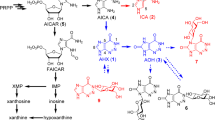Abstract
Physiological studies of 5-fluorouracil (5-FU)-resistant cell line of wild carrot (Daucus carota L.), F5, showed that this variant is also resistant to 5-fluorouridine, but is as sensitive to 6-azauracil as the 5-FU-sensitive parent line, WOO1C. High levels of exogenous uracil, uridine, and thymine are slightly toxic to F5, but not to WOO1C. 5-FU sensitivity in WOO1C cannot be reversed by bases and nucleosides; bases like uracil and thymine even increase 5-FU toxicity. No substantial differences were found in the uptake, incorporation and degradation of WOO1C and F5. Carrot cultures seem to take up 5-FU by rapid diffusion, the kinetics being characteristic of non-saturable uptake, with infinite Km and zero Vmax. The rapid uptake of 5-FU and extensive degradation of bases and nucleosides are probably responsible for the inability of uracil and uridine to reverse the growth inhibition caused by 5-FU in carrot cells while, as shown earlier, phaseolotoxin ((N-phosphosulfamyl)ornithinylalanylhomoarginine), an inhibitor of the arginine biosynthetic enzyme, ornithine transcarbamylase was capable of reducing 5-FU toxicity. F5 callus contained less histidine and arginine than WOO1C. 5-FU increased the endogenous levels of arginine, histidine and aspartate in both lines. The aspartate transcarbamylase of F5 appears to be normal; it is as sensitive to uridine-monophosphate inhibition as that of WOO1C. The 5-FU resistance of F5 was stable in undifferentiated cells, but only 8 out of 50 calli reinitiated from the regenerated plantlets remained resistant to 5-FU. F5 is an aneuploid culture. Five 5-FU-sensitive reinitiated calli that were examined were all diploid whereas of the eight 5-FU-resistant reinitiated calli two became diploid and six remained as aneuploid.
Similar content being viewed by others
Abbreviations
- 5-FU:
-
5-fluorouracil
References
Anderson, E.P., Brockman, R.W.: Feedback inhibition of uridine kinase by cytidine triphosphate and uridine triphosphate. Biochem. Physiol. Acta 91, 380–386 (1964)
Berlin, R.D., Oliver, J.M.: Membrane transport of purine and pyrimidine bases and nucleosides in animal cells. Int. Rev. Cytol. 42, 287–336 (1975)
Bradford, M.M.: A rapid and sensitive method for the quantification of microgram quantities of protein utilizing the principle of protein-dye binding. Anal. Biochem. 72, 248–254 (1976)
Brockman, R.W., Davis, J.M., Stutts, P.: Metabolism of uracil and 5-fluorouracil by drug-sensitive and by drug-resistant bacteria. Biochim. Biophys. Acta 40, 22–32 (1960)
Gerhart, J., Pardee, A.: Spectrophotometric assay for carbamyl aspartate. J. Biol. Chem. 237, 891–896 (1962)
Heidelberger, C., Ghoben, A., Baker, R.H., Mukherjee, K.L.: Studies on fluorinated pyrimidines. X. In vitro studies on tumor resistance. Cancer Res. 20, 897–901 (1960)
Hartman, K.-U., Heidelberger, C.: Studies on fluorinated pyrimidines. XIII. Inhibition of thymidylate synthetase. J. Biol. Chem. 236, 3006–3013 (1961)
Jacques, S.L., Sung, Z.R.: Effects of halo blight toxins on pyrimidine and arginine biosynthesis in cell culture of Daucus carota L. Proc. IV Int. Conf. on Plant Pathogenic Bacteria, vol. II, pp. 657–661. France: Stat. Pathol. Vég. et Phytobacteriol. 1978
Jund, R., Lacroute, F.: Genetic and physiological aspects of resistance to 5-fluoropyrimidines in Saccharomyces cerevisiae. J. Bacteriol. 102, 607–615 (1970)
Lacroute, F., Pierard, A., Grenson, M., Wiame, J.M.: The biosynthesis of carbamylphosphate in Saccharomyces cerevisiae. J. Gen. Microbiol. 40, 127–142 (1965)
Leaver, C.J., Key, J.C.: Polyribosomal formation and RNA synthesis during aging of carrot-root tissue. Proc. Natl. Acad. Sci. USA 57, 1338–1344 (1967)
Maliga, P.: Resistant mutants and their use in genetic manipulation. In: Frontiers of Plant Tissue Culture, pp. 381–392, Thorpe, R.A., ed. Univ. of Calgary, Canada: Int. Ass. for plant Tissue culture 1978
Mandel, H.G.: The incorporation of 5-fluorouracil into RNA and its molecular consequences. Progr. Molec. and Submolec. Biol. 1, 82–135. Berlin, Heidelberg, New York: Springer 1969
Neumann, J., Jones, M.E.: End-product inhibition of aspartate transcarbamylase in various species. Arch. Biochem. Biophys. 104, 438–447 (1964)
Ohyama, K.: A basis for bromodeoxyuridine resistance in plant cells. Environ. Exper. Bot. 16, 209–216 (1976)
Ong, B.L., Jackson, J.F.: Aspartate transcarbamylase from Phaseolus aureus. Biochem. J. 129, 571–581 (1972a)
Ong, B.L., Jackson, J.F.: Pyrimidine nucleotide biosynthesis in Phaseolus aureus. Biochem. J. 129, 583–593 (1972b)
Sander, E.G., Sedor, F.A., Young, E.: The dehalogenation of 5-halo-5,6-dihydrouracil. Bioorg. Chem. 5, 231–239 (1976)
Sedor, F.A., Jacobson, D.G., Sander, E.G.: The dehalogenation of iodouracil by cysteine. Intramolecular general acid catalysis of cysteine addition to 5-iodouracil. Bioorg. Chem. 3, 154–162 (1974)
Smith, S.M., Street, H.E.: The decline of embryogenic potential as callus and suspension cultures of carrot (Daucus carota L.) are serially subcultured. Ann. Bot. 38, 223–241 (1974)
Sung, Z.R.: Turbidimetric determination of plant cell culture growth and its applications. Plant Physiol. 57, 460–462 (1976a)
Sung, Z.R.: Mutagenesis of cultured plant cells. Genetics 84, 51–57 (1976b)
Sung, Z.R.: Relationship of indole-3-acetic acid and tryptophan concentrations in normal and 5-methyltryptophan-resistant cell lines of wild carrot. Planta 145, 339–345 (1979)
Sung, Z.R., Smith, R., Horowitz, J.: Quantitative studies of embryogenesis in normal and 5-methyltryptophan-resistant cell lines of wild carrot: The effects of growth regulators. Planta 147, 236–240 (1980)
Wasternack, C.: Degradation of pyrimidines in Euglena gracilis. I. Studies with intact cells. Plant Sci. Lett. 4, 353–360 (1975)
Wasternack, C.H.: Uptake and incorporation of pyrimidines in Euglena gracilis. Arch. Microbiol. 109, 167–174 (1976)
Wasternack, C., Reinbothe, H.: Degradation of pyrimidines in Euglena gracilis. II. Inhibition of degradation by structural analogues and their own degradation. Plant Sci. Lett. 9, 171–178 (1977)
Widholm, J.M.: Cultured Nicotiana tabacum cells with an altered anthranilate synthetase which is less sensitive to feedback inhibition. Biochim. Biophys. Acta 261, 52–58 (1972)
Author information
Authors and Affiliations
Rights and permissions
About this article
Cite this article
Sung, Z.R., Jacques, S. 5-Fluorouracil resistance in carrot cell cultures. Planta 148, 389–396 (1980). https://doi.org/10.1007/BF00388128
Received:
Accepted:
Issue Date:
DOI: https://doi.org/10.1007/BF00388128




